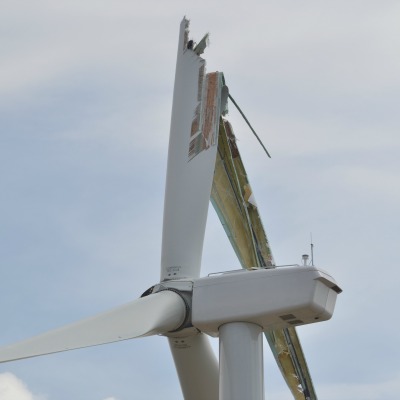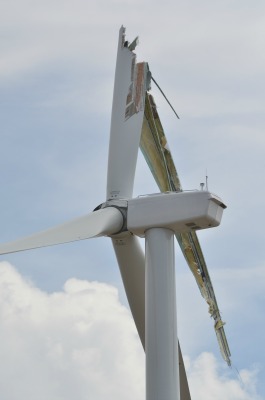 Within a two-week time span, there were recently two separate blade failures at Invenergy's Prairie Breeze wind farm. Located in Nebraska, the 200.6 MW project features 1.7 MW GE wind turbines and was newly commissioned.
Within a two-week time span, there were recently two separate blade failures at Invenergy's Prairie Breeze wind farm. Located in Nebraska, the 200.6 MW project features 1.7 MW GE wind turbines and was newly commissioned.
According to Alissa Krinsky, a spokesperson for Invenergy, the blade incidents occurred on April 21 and May 4. No one was injured.
In a statement, Krinsky explains that a section of a blade fell to the ground at around 1:00 p.m. CST on Monday, April 21. She says the structural failure happened at the wind farm's 51st unit, and the turbine "is not being operated at this time while we work with GE, the turbine manufacturer, to determine the cause of this incident."
The second blade failure, at the project's 11th unit, happened at approximately 2:45 p.m. CST on Sunday, May 4. Again, Krinsky says pieces of the blade fell to the ground and the turbine is no longer operating.

One of the broken GE turbines at the Prairie Breeze wind farm. Photo courtesy of The Elgin Review.
The project's 1.7 MW turbines feature 48.7-meter blades, which GE has had issues with in the past. As NAW reported last year, the company blamed a "spar cap manufacturing anomaly" for two other blade breaks: one at Invenergy's Orangeville wind farm in New York, and another at DTE Energy's Echo Wind Park in Michigan. Both of those wind farms have 1.6 MW GE turbines.
In December, GE said it had identified other customers whose wind turbines were subject to the manufacturing defect and quietly instituted a blade-replacement program across its fleet to address the issue.
Invenergy's Orangeville wind farm has since entered commercial operation, and Krinsky says there have not been any new blade incidents at the project site. She notes that GE had "determined that a limited number of blades on turbines at the Prairie Breeze Wind Energy Center needed to be replaced due to a manufacturing defect, and completed doing so this past winter." Invenergy declined to comment further until the cause of the two new blade failures is identified.
Regarding the Prairie Breeze incidents, GE spokesperson Lindsay Theile simply explains, "In an event like this, it's our process to work with our customers and assign a team to do a root-cause analysis to determine what happened."
However, GE has declined to comment whether the two broken blades were ones that were replaced in the winter or provide more details about the previously announced spar cap issue, including the name of the blade manufacturer.
In April, NAW also learned that GE is investigating a blade break that occurred at the Wildcat 1 wind farm in Indiana. The 200 MW project, owned by E.ON Climate & Renewables North America, features 1.6 MW turbines. Notably, though, Theile has said early signs suggest lightning likely caused that incident. The root-cause analysis is ongoing.



